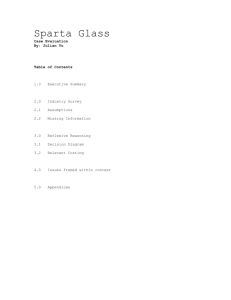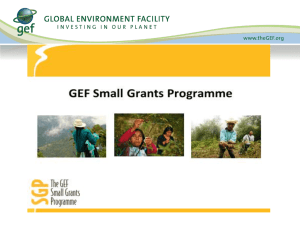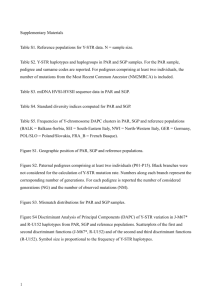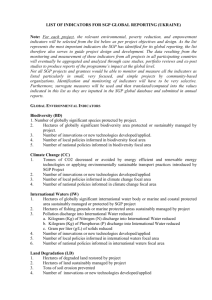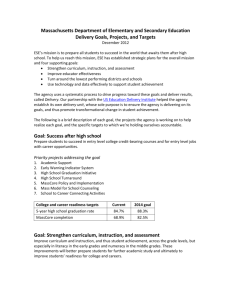Regional Programme - English - Global Environment Facility
advertisement
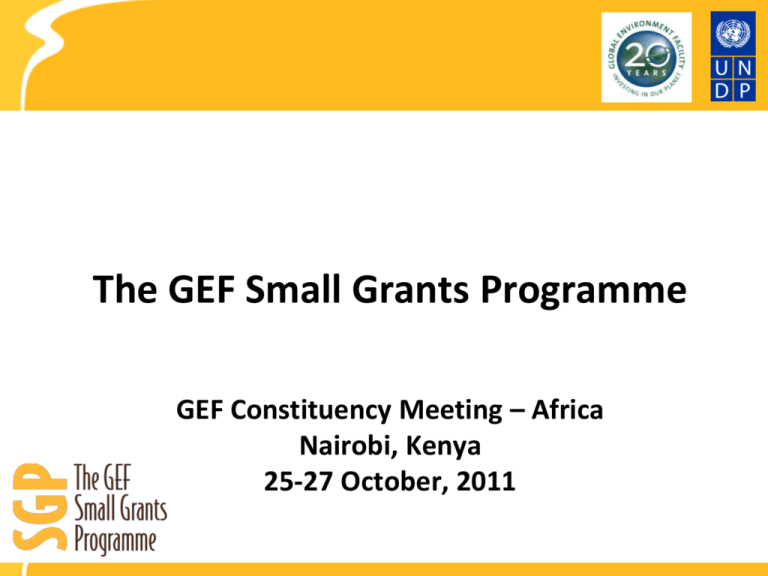
The GEF Small Grants Programme GEF Constituency Meeting – Africa Nairobi, Kenya 25-27 October, 2011 SGP REGIONAL OVERVIEW Country Start Up Date Total Number of Projects Grant Amount: In Cash Cofinancing: In Kind Cofinancing: COMOROS 2006 26 757 499 USD 465 135 USD 203 232 USD ERITREA 2009 9 300 000 USD 183 031 USD 154 948 USD ETHIOPIA 2005 75 2 246 054 USD 717 495 USD 1 653 516 USD KENYA 1993 287 7 678 115 USD 3 040 698 USD 1 909 468 USD MADAGASCAR 2007 125 2 287 500 USD 874 103 USD 784 881 USD MAURITIUS 1995 118 3 376 273 USD 4 101 295 USD 2 977 848 USD RWANDA 2005 33 1 474 127 USD 291 861 USD 431 795 USD SEYCHELLES 2007 11 475 062 USD 172 333 USD 105 508 USD UGANDA 1997 156 4 465 811 USD 1 982 533 USD 1 717 466 USD TANZANIA 1996 226 5 809 309 USD 1 828 244 USD 1 470 552 USD SGP REGIONAL OVERVIEW Regional Portfolio Distribution by Focal Area Climate Change 26% International Waters 6% Multifocal Area 2% Persistent Organic Pollutants 1% Land Degradation 31% Biodiversity 33% Climate Change Adaptation 1% SGP COMOROS Examples of Successful Projects Support for techniques cost effective and environmental friendly Goal: reduce pressure on resources and fishermen using destructive techniques Main Activities: development of new techniques for profitable fishing (longline and lobster); fishermen training; equipment storage, freezing and transport of fish. Key Results: Co-management agreement of marine resources, improved ecosystems, and improved income of traditional fishermen Protection of endangered marine species (coelacanth, marine turtles) Goal: To protect and conserve the endemic marines species Main Activities: Training of youth and women on management of natural resources, in particular to protect the turtles and coelacanth. Key Results: developed and equipped environmental conservation and protection centers in Itsoundzou-Ngazidja and a turtle protection center of turtle in ItsamiaMoheli Agricultural irrigation for rural women Goal: conserve water resources and promote sustainable farming Main Activities: reforestation, installation of the water network, production plants, gardening equipment and development activities Key Results: improved community management of water resources, raised awareness and capacity of the community on environmental conservation and sustainable farming SGP ERITREA Examples of Successful Projects Rehabilitation of Hirgigo Mangrove forests Goal: Rehabilitation and stabilization of Hirgigo mangrove forests Main Activities: seed collection from established forests, mangrove planting and fertilizing, provision of 60 small ruminants, demonstration of mangrove utilization as fodder crop, and awareness raising seminars. Key Results: 22.50 ha of sea coast covered with 30,000 mangrove seedlings. Improved Traditional Stoves in three villages of Adi-tekelezan Sub-region Goal: Reduction of GHG emissions by using improved traditional stoves Main Activities: Collection of gravel and selected soil texture for stove making, train women masons to construct the stove, and plant trees in homestead. Key Results: 400 improved traditional stoves constructed and are under efficient use, reducing tree cutting for fire wood, improved health condition of women. Promotion of afforestation and land reclamation in Sub region Adi-tekelezan Goal: Combat soil erosion and conserve water resources through reforestation. Main Activities: Protect area from animal grazing and other human activities, terracing, tree planting, and awareness raising on the importance of vegetation cover in conserving water and soil from erosion. Key Results: 30 Ha of land protected from grazing and 59,990 of seedlings planted. Project site already covered with vegetation. SGP ERITREA Country Level Impact SGP impact in figures: 40 Hectares of land under afforestion programme protected from animal grazing, 3km of sea coast land under mangrove rehabilitation project protected, rehabilitated and sustainably managed. SGP Policy Influence at the Local level: Local authorities are very supportive protecting areas by practice where SGP projects of land degradation and biodiversity are implemented. This attitude is going beyond the communities to regional and national levels. Influence at national level: The only green belt area on the eastern escarpment of Eritrea known as Semienawi Bahri which is significantly large, was at risk of severe degradation from intensive farming and animal grazing during the last 20+ years. The government has recently declared the enclosure of the area from any agricultural activities to protect it from further degradation and boost biodiversity. This shows that there is strong influence of protecting areas from overgrazing and other human activities. Women sensitization was the key for success SGP Ethiopia Examples of Successful Projects Agro-biodiversity through Sustainable Land Management Goal: To Conserve Biodiversity through Sustainable Land Management Main Activities: Conserving locally important farmers’ varieties Key Results: Multiplication of extinct farmers’ varieties for cultivation/production Farmland planted with barley variety Community Based Sustainable Environmental Management Plan Goal: Rehabilitation of degraded natural resources Main Activities: Soil and water conservation (SWC), Compost preparation, area closure and fuel saving stoves Key Results: Rehabilitated 42ha of land through area closure and physical SWC activities Rehabilitation and Conservation of Natural Resources Goal: Rehabilitating degraded land Main Activities: Establishing and managing central and group tree nurseries Key Results: 24 ha of privately owned and communal land rehabilitated, 558,781 different types of indigenous and exotic tress were raised and planted in this enclosed area Physical structure conserving rainfall Seedlings distribution SGP Ethiopia Country Level Impact SGP Impact in figures: • (4) barley types, locally known as, Senef Kolo, Temejz, Nech Gebis and Tikur Gebis that were almost extinct are now being multiplied by the local farmers for use and/or sale. • More than 3,000 ha of land was enclosed and rehabilitated. SGP Policy Influence: • As a result of the good work that SGP is doing, the government allocated part of its RAF and STAR resources to SGP. This indicates that the working relationship between the CSOs and the government is smooth. Out of the 57 CBOs SGP-Ethiopia is supporting, 50 of them were established as a result of SGP’s intervention opportunity. Replication and Up Scaling: • The Solar and Compost preparation projects in the Amhara region were well acknowledged by the local administration and being replicated in other communities. SGP Kenya Example of successful project Tungu Kabiri Community micro-hydropower project Goal: Provide the Tungu Kabiri community with suitable, off-the-grid energy options to meet energy service needs in Kenya Main Activities: Training on operation and maintenance of the microhydropower system. Installation of the system. Establishment of a microenterprise shopping center. Key result: Established micro-hydropower system, contributed directly to the National Energy Policy, which addressed limitations that hindered decentralized power schemes, subsequently, over 50 pico and micro hydropower systems installed in various parts of the country by communities. Community butterfly farming in Arabuko Sokoke Goal: Contribute to the conservation of the indigenous Arabuko sokoke forest Activities: Train farmers on butterfly farming, establish butterfly rearing pens, marketing, Key results: Number of farmers involved in butterfly farming has grown from 60 to 800; project replicated in another indigenous forest; pressure on the forest reduced SGP Kenya Successful Initiative The World Heritage Local Ecological Entrepreneurship Program (WH- LEEP) • A Conservation International(CI)/Verde Ventures (VV) partnership with SGP COMPACT • The initiative that provides grants (for BDS) and loans to small businesses and entrepreneurial activities which promote the conservation of biodiversity found within World Heritage Sites, to enable them to scale-up their operations. • 4 have received grants worth USD 10,000 for BDS. They are: – Top Notch: recycles plastics and produces buckets, boots, basins, etc – Kimahuri Youth Group : involved in trout farming and silk-worm rearing – Water resources management (WRM): promotes irrigation and food security through production of low-head irrigation drip kits – Nyala Dairy Cooperative: provision of domestic solar units and biogas units for 2000 households • Top Notch and WRM about to receive loans of USD 50,000. SGP Kenya Country Level Impacts SGP policy impact • SGP project directly influenced National Energy Policy which resulted in the creation of an enabling environment for decentralized power production. • SGP project contributed to the gazettment of 11 sacred sites as national monuments Successful projects scaled up and replicated • Installation of EE cookstoves in schools + woodlot establishment in school compounds • Butterfly farming on the edges of indigenous forests • Eco-tourism to promote forest (terrestrial and marine)conservation SGP activity in figures • 6 globally important and highly threatened fauna species protected • 12,500 ha of terrestrial indigenous forest and 3,700 hectares of mangrove forest rehabilitated and/or sustainably managed. SGP Madagascar Example of Successful Projects Forest and biodiversity conservation by land valorization and use of efficient cook stoves: 7 projects in the Southwest of Madagascar Goal: Conservation of dry forests in community conserved areas around 2 new protected areas: Tsimanampetsotse and Mikea complex Main activities: Community forest management; Valorization of degraded lands by sustainable agriculture techniques and efficient products storage; use of efficient biomass cook stoves by schools and households awarded by Tany Meva Foundation Key results: No more forest loss for 1800 ha of community managed forest; sustainable use of forests products : honey, yams; 350 ha of degraded land valorized, decrease from 4 to 1 to 0 month of food shortage; 80% decrease in wood consumption for cooking Conservation of community marine reserves in the Bay of Ranobe Goal : To conserve the “Roses Garden” coral reeves and 3 community marine reserves, a part of the 3rd largest coral barrier in the world, a sanctuary of pelagic fauna and flora and an attractive tourist site Main activities : Communication on biodiversity and community social commitment, support to seaweeds culture, mangrove restoration Key results: Tourists, fishermen, women and children engaged in the conservation of the reserves; production of 40 tons/year of dried seaweeds that increased the income of 68 households by 3 in 2 years with an increase interest and demand; decrease of 50 % of the seine net fishers within 2 year; expected total abandonment of unsustainable fishery and coral reeves destruction within the 2 coming years. SGP Madagascar Country Level Impact • • • • 16 news and existing protected or conserved areas influenced in landscapes 750 000ha 13 communities conserved areas supported of 3 900Ha 2000ha of degraded land valorized 100 households from 10 CBO grantees awarded by Tany Meva Foundation with pipa cook stove Chief Executive Tany Meva Foundation Grantee National Coordinator GEF SGP Madagascar Grantee • • • • Two grantees awarded by equator prize 2 local consultative bodies operational 1 national network of more than 110 CBOs and NGOs formed on GEF concerns and influencing National Policy and Strategy on Communitybased environmental governance 1 new code of protected areas considering Community -Based Governance National Coordinator UN System in Madagascar Grantee Mayor Rural Commune of Ankililoaka Grantee SGP MAURITIUS Examples of Successful Projects Sustainable Reef Fisheries Development in the Rodrigues Lagoon Goal: Creation of no-take marine zones via dialogue and policy measures Main Activities: Data collection, marine biodiversity surveys, training and sensitization of the fisher community to win their support and commitment towards the creation of marine reserves where they would not be able to fish. Key Results: Discovery of new endemic fishes and corals; successful policy dialogue; 4 marine reserves proclaimed by the Rodrigues Regional Assembly; Winner of the 2006 AGFUND Prize. Biogas Production for the Ecological and Economic Treatment of Cattle Waste Goal: Decrease GHG, produce biogas energy for cooking while improving livelihoods Main Activities: Construction of biogas digesters, capacity development Key Results: 7117.5 m3 of CO2 equivalent avoided per year. Produce 10 m3 of rich organic fertilizer per day. Beneficiaries save $40 a month from the purchase of liquefied petroleum Sustainable Agricultural Technologies Goal: Reduce usage of chemical fertilizers, pesticides and herbicides that affect the fragile lagoonal waters of the Indian ocean; address sustainable land management. Main Activities: building capacity and sharing knowledge in the area of composting as well as developing community wide composting programs over the whole island. Key Results: Reduced use of chemical fertilizers by approximately 75% thereby reducing pollution and run-offs to the lagoons and waterways, enabled access to cheaper fertilizers Generated additional income activities in collecting and maintaining compost; Rotary composters won the 2009 African Union Commission Award for Women Researchers SGP MAURITIUS Country Level Impact •Several projects have had significant policy influence on government actions. •New endemic species of fish and corals have been discovered and one of the world’s most threatened parrots has been saved from extinction and downgraded from the IUCN List of Critically Endangered species in 2007. •Grantees have won 17 awards in recognition of their SGP funded projects, 6 of which are prestigious international ones, including the 2001 Whitley Foundation Award, the 2003 Energy Globe Award and the 2006 AGFUND Prize. Here please insert a picture. i.e. you use a picture of a publication, poster you have developed, or a map that shows the projects you have at the country level SGP Rwanda Examples of Successful Projects Promotion of vegetative multiplication Goal: stop the collection of bamboo rhizomes from parks (natural forests) Main Activities: trainings, demonstrative nurseries and bamboo plantations. Key Results: bamboo protection adopted by national strategies/projects for: SLM, CC mitigation, river protection, handcrafts and furniture, expertise exported Briquettes making from domestic waste Goal: Reduce tree cutting for charcoal Main Activities: equipment, capacity building and awareness raising Key Results: more than 2,5MT of briquettes made per year, 110 jobs created ECOSAN promotion (phases I& II) Goal: Reduce under ground water pollution, promote organic farming Main Activities: awareness raising , design demonstration, barriers removing on human excreta use as fertilizers, Key Results: ECOSAN adopted by national policies ( schools and public places), demonstrative field, 1.5 t per month of manure produced (so far) SGP Rwanda Country Level Impact •GEF SGP Rwanda has supported 33 projects since 2006. •Most of them were pilot projects (now being replicated/up scaled) which promoted new technologies/approaches and targeted vulnerable groups. •The biggest impact for GEF SGP Rwanda was in climate change and waste management with technologies introduced/improved : biogas, composting, briquettes and plastic recycling •The country programme also successfully promoted bamboo, the mechanical control of water hyacinth in lakes, solar energy. •Awards: AFRICASAN award (2011) , 2 preselected for SEEDS award 2011. SGP Seychelles Examples of Successful Projects Piloting participatory research of rabbitfish in an fisheries co-management set-up Goal: participatory research the stock of rabbitfish around island of Praslin Main Activities: tagging of rabbitfish, monitoring movement by acoustic stations, underwater visual surveys Key Results: improved monitoring and research about the rabbitfish, empowerment of island fishermen, improved communication with national institutions. Promoting Rainwater harvesting on the island of La Digue Goal: encourage rainwater harvesting on La Digue as ground water is polluted Main Activities: education & awareness, installation of harvesting systems for home & Schools Key Results: sale of rainwater tanks & ordinary barrels for rainwater harvesting to community members Saving Our Seychelles-Glass recycling-Training Element Goal: Provision of specialized training for at least 6 unskilled young in glass casting and glass blowing which will provide a source of livelihood Main Activities: 3 months Training from a specialist Kenyan trainer, branding and marketing of glass product Key Results: decreased over 100KG per month of glass going into the landfill , provide skills to all trainees, increase recycled glass product range for sale SGP SEYCHELLES Country Level Impact •SGP Seychelles was launched in 2009 and since then has funded 10 projects which are all currently under implementation. • Slowly the programme is gaining momentum and is being recognised by Government as a mechanism for small community projects. •SGP impact in figures: 15 significant species protected •SGP Policy Influence at National Level: 2 projects are directly working to influence national policies in recognising trainees of glass recycling as viable training worthy of government assistance; and piloting fisheries comanagement which is a first for Seychelles. SGP Tanzania Examples of Successful Projects • Conservation of biodiversity in the Eastern Arc Mountains Goal: Conservation of biodiversity by using community-level approaches Main Activities: Tree planting, beekeeping and use of improved stoves Key Results: Reduced deforestation, income generation to local communities and reduced carbon emissions • Promotion of renewable energy technologies for water pumping Goal: To demonstrate use of solar and wind energy for water pumping Main Activities: Capacity building for and demonstration of the technologies Key Results: Wider adoption of water pumping technology through wind and solar energy SGP Tanzania Country Level Impact •One CCA recognized and registered as a Wildlife Management Area (WMA). This CCA is located on the fringes of the famous Selous Game Reserve •The protected area around which SGP was operating has been elevated to a status of Nature Reserve. The new Nature Reserve is called ULUGURU. •Over 5,000 households adopted fuel efficient cook-stoves, which improves cooking efficiency by 30% and reduce carbon emission at the tune of 120,000 tonnes of carbon dioxide (tCO2) per year. • SGP grantees through COMPACT will be supported to upscale their community conservation initiatives under a new GEF FSP on SLM in Kilimanjaro region (2011-2014) • A water dam has improved livelihood of Indigenous communities locally known as hadzabe, who are on the verge of extinction • SGP Tanzania is a recipient of 4 global awards: (i) UNDESA award for water and watershed management (ii) BDP award on MDGs acceleration (iii) Kyoto award on waterand climate change (iv) Gold medal on bee-keeping. SGP UGANDA Examples of Successful Projects Musambwa Island Conservation Project Goal: To protect the breeding grounds of migratory birds Main Activities: Participatory development of bye-laws and ordinance for the protection of Musambwa Island as a bird sanctuary Key Results: Protection of largest breeding colony of the Grey Headed Gull in Africa Senyi Eco-Sanitation Project Goal: To establish and maintain a reliable supply of (piped) potable safe water, toilet facilities, and hand washing facilities Main Activities: Build a gravity-flow water system, rainwater collection & storage, water-borne toilets and hygiene education Key Results: Senyi fish landing site satisfies the international hygiene regulations and is leading source of Uganda’s fish exports. Minani Fruit Tree Project Goal: To promote sustainable and profitable land management Main Activities: Training and supporting farmers in growing export quality fresh mangoes Key Results: 240 hectares under sustainable land care as mango orchards. Initial commercial harvests yielded fresh mangoes sold by local project beneficiaries earning US$ 37,696 in 2008 & US$ 131,578 in 2009 SGP UGANDA Country Level Impact SGP projects supported , documented and influenced: • At national level: Ordinance enacted declaring Musambwa Island a bird sanctuary, recommendation made by parliamentary committee to include energy saving stove/technology among basic requirements and minimum standards for boarding schools, Lakes Bisina, Opeta & Nakua designated as Ramsar Sites • At local level: Bye-laws passed by local governments in the shea belt for protection of shea nut trees in savannah grasslands Successful projects scaled up, replicated or won award: • Community-Based Conservation for Wetlands Biodiversity (COBWEB), a GEF Medium size project is a replication and scaleup of SGP’s Katonga Wetland Conservation Project which had an important impact in raising awareness regarding the significance of wetlands as biodiversity hot-spots in semi-arid areas • Kibale Association for Rural & Environmental Development (KAFRED) won the UNDP Equator Prize for the second time in 2010 for the Conservation & Community Development Project Final Notes • While SGP projects are small, when they are strategically implemented and build up over time, then the positive impacts go beyond the community to the country and even the global level. • SGP is a “fast and effective delivery mechanism” that allows communities, CBOs and NGOs who may not be able to access GEF funds to be able to do so and in the process build their capacity to be proactive actors in the country’s sustainable development efforts. • SGP can be a delivery mechanism for other donors who may wish to be a cofinancing partner and want to save on time and other costs by using an already existing and effective mechanism that brings communities, CSOs and government to work together. Local Actions, Global Impact Questions? THANKS!
